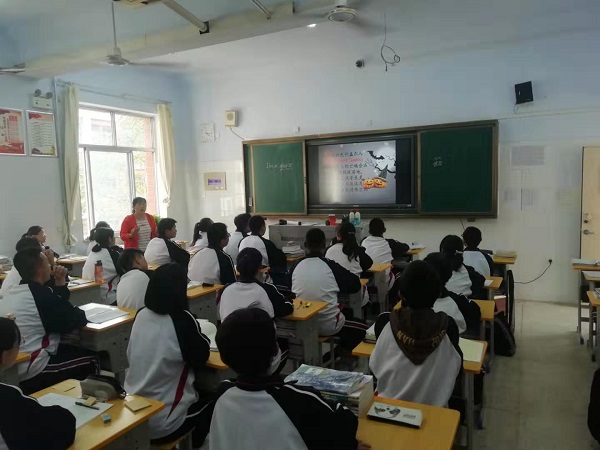|

The contrast of Halloween and the Ghost Day of
China(中元节)
Teaching design:English learning is not only about knowledge, but also about its culture
and customs. So in this semester, we introduce the western festival Halloween
to guide students to know more about life in English-speaking countries, and
help students overcome some culture shocks in English learning. Therefore, I
introduce The contrast of Halloween and the
Ghost Day of China(中元节) .
Learning aims:
1.To learn the origin, main activities, and traditions of the two
festivals: Halloween and the
Ghost Day of
China(中元节)。
2. Through the
analysis of the differences and similarities of the two festivals, students can
learn the western festival, which can broaden their horizons.
Teaching procedures:
Step1: Lead-in:
Show a short song Trick or Treat and ask students to follow the song, and then guess the
western festival referred to in the song. In this class, let’s learn more about Halloween.
1. When is Halloween celebrated every
year?
2. The Origin of Halloween
3. The Traditions : Food &Costume
Jack-o'-lantern
Trick or Treat
Step2: The the
origin of Halloween
Halloween, or
Hallowe’en, is a holiday celebrated on October 31. Irish immigrants carried
versions of the tradition to North America in the nineteenth century. Other
western countries embraced the holiday in the late twentieth century. Halloween
is celebrated in several countries of the Western world, most commonly in the
United States, Canada, Ireland, Japan, New Zealand, United Kingdom and
occasionally in parts of Australia.
The ancient Gaels
believed that on October 31, now known as Halloween, the boundary between the
alive and the deceased(死亡) dissolved(消失),
and the dead become dangerous for the living by causing problems such as
sickness or damaged crops. The festivals would frequently involve bonfires(营火),
into which bones of slaughtered livestock were thrown. Costumes and masks were
also worn at the festivals in an attempt to mimic(模仿)
the evil spirits or placate(安抚,平息)
them.Halloween has its origins in the ancient Celtic(凯尔特人 )festival known as Samhain(萨温节).The festival of
Samhain is a celebration of the end of the harvest season in Gaelic(盖尔族的, 盖尔语的) culture, and is sometimes regarded as the "Celtic New
Year". Traditionally, the festival
was a time used by the ancient pagans(异教徒, 非基督教徒,没有宗教信仰的人) to take stock of (估计, 观察)supplies and slaughter livestock(家畜)
for winter stores.
Step3: Show the
background connected with the festival.
Witches(女巫)
Witches
were thought to be tellers of fortune and to cast spells, both good and
bad. This frightened many because it was
believed that these powers were strongest on Halloween night. The image of a
witch has greatly changed over the centuries.Once thought of as old, wrinkled,
green skinned hags, many people associate witchcraft to either evil or as being
wise.Witches and broomsticks go hand in hand. They have been associated for
centuries. Often, witches are depicted riding them across the night sky with a
black cat on one end.It is believed that because Halloween occurred during the rainy
season, women used their broomsticks to vault over large puddles and to sweep
water out of their paths while walking.Thus, the two became associated.
Jack-o-lanterns(南瓜灯)
People
have been making Jack-o-lanterns at Halloween for centuries. The practice
originated from an Irish myth about a man known as “Stingy Jack.”Stingy Jack
one day invited the Devil to have a drink with him. Not wanting to pay for the
drink, he tricked the Devil into turning
himself into a coin, and then put the Devil into his pocket next to a cross
that prevented the Devil from changing back into his original form.Jack freed
the Devil after the Devil promised not to bother Jack or, should he die, claim
his soul.Eventually, when Jack did die, God would not take him into Heaven, and
the Devil, who had promised not to claim Jack’s soul, could not take him into
Hell.Thus, the Devil sent Jack’s spirit into the night with only a burning candle to light his way. Jack put the candle into a carved out turnip and has been roaming the
Earth ever since.The Irish began to refer to this ghostly figure as “Jack of
the Lantern,” and then simply as “Jack-o-lantern.”
Trick
or Treat(不给糖就捣乱)
Trick-or-treating,
is for children on or around Halloween in which they proceed from house to
house in costumes, asking for treats such as confectionery with the question,
"Trick or treat?" The "trick" part of "trick or
treat" is an idle threat to play a trick on the homeowners or their
property if no treat is given.
Step4: Enjoy some
pictures of the festival
Step5: introduce the Ghost Day of China(中元节) :
中元节,别名七月半、七月十四、祭祖节、盂兰盆节、地官节,节日习俗主要有祭祖、放河灯、祀亡魂、焚纸锭、祭祀土地等。“中元节”是道教的叫法,民间世俗称为“七月半”(或“七月十四”),它的产生可追溯到上古时代的祖灵崇拜以及相关时祭。节期与古老文化中的阴阳消长循环之理有关,在《易经》中,“七”是一个变化的数字,是复生之数。七月乃吉祥月、孝亲月,七月半是民间初秋庆贺丰收、酬谢大地的节日,有若干农作物成熟,民间按例要祀祖,用新米等祭供,向祖先报告秋成。该节是追怀先人的一种文化传统节日,其文化核心是敬祖尽孝。“七月半”原本是上古时代民间的祭祖节,而被称为“中元节”,则是源于东汉后道教的说法。道教有“三元说”,“天官上元赐福,地官中元赦罪,水官下元解厄,“中元”之名由此而来。佛教则称七月半为“盂兰盆节”。在统治者推崇道教的唐代,道教的中元节开始兴盛,逐渐将“中元”固定为节名,节期设在七月十五日,并相沿迄今。七月十四/十五祭祖是流行于汉字文化圈诸国以及海外华人地区的传统文化节日,与除夕、清明节、重阳节均是中华民族传统的祭祖大节。2010年5月,文化部将香港特区申报的“中元节(潮人盂兰胜会)”入选,列入国家级非物质文化遗产名录。
中元节的文化内涵
中元节是一个异彩纷呈,有着丰富文化内涵的节日。它不仅拥有佛教的宗教信仰,还有着我国道教的本土文化。中元节是我国传统文化的一个载体,它反映了人们的鬼神观念和宗教信仰,同时还有我国文化的精髓——孝道文化。
按照佛教的说法,中元节的来源是目连救母的故事,目连不忍母亲在地狱受苦,广施十方僧人,替母亲赎罪,最终将母亲解脱出来。这个故事在民间流传甚广,故事的本身就是孝道文化的一种表现,它所宣扬的便是报答父母、生前为善的信念。
此外,中元节的习俗是祭祀先祖。祭祀活动在商周时期已经有文献记载,《诗经》的40篇《颂》即是祭祀乐歌,它所反映的是人们最原始的一种祖先崇拜。另外,祭祀活动在我国几千年文化的演变之中,和后来儒家所倡导的孝道文化融为一体,密不可分。
孝可以简单地理解为善事父母,而从深层意义上来说,孝更是一种伦理规范,一种处理宗族关系的方式,一种秩序的建立。祭祖表达的是对先人的思念与缅怀,它是维持宗族关系的一种很重要的方式,可以说,祭祖正是这种宗族关系的一种反映,一个寄托。
中元节是孝道文化的传承,是人们情感的载体。作为我国古代文化核心之一的孝道,受到儒释道三家的极力推崇,即使是在今天,孝道文化依然经久不衰。重视中元节,提倡传统孝道,对于我们的社会发展是大有裨益的。
中元节的双重意义
从有关中元节的传说,以及中元节的文化中,可以体会到中元节具有双重意义,人们在开展中元活动的时候,要跳脱鬼的角度,传承孝道文化。
一是阐述怀念祖先的孝道,让人们慎终追远,以及对先祖的怀念与感恩之情。
二是发扬推已及人,救济众生的义举,换得世界清平。
Step6:
enjoy some pictures about the Ghost Day
of China(中元节) :
Step6: Summary
By learning about The contrast of Halloween and the Ghost Day of China(中元节) , do you have
something to say?
Now let’s work in
groups and discuss what you think about it.
课后反思
语言的学习离不开文化的理解,了解西方文化是在教学中对学生进行语言的文化背景的发掘、 扩展和利用。
本课中,我结合中西方国家不同节日的对比,了解西方的风土人情,扩展学生的知识背景。我先播放了一段视频儿歌,激发学生兴趣,带入课堂情境。然后以一个问题:When does the western festival take place? What else do you know about it? 要求学生有条理地表达自己的观点。 我很高兴地看到学生都能较好地完成这个读写任务,语言较通顺流畅,观点鲜明。学习完这两种节日之后,最后,学生对其有了更深的了解,并要求学生就一种或两种节日发表自己的一点感悟(字数100词左右),形成文字并要求他们在堂上相互朗读自己的作文,我都为她们一一作了评讲, 通过本课的教学, 我体会到: 我们所选取的教材为我们提供了较先进的、
赖以指导学生开展有效的综合训练的好材料。
在采用教材开展教学活动的过程中, 我们必须通过对教材的认真分析和研究, 在备课中做到心中有数,得心应手地进行取舍或补充,做到有条不紊地处理教材, 进而顺利、
有效地借助教材资料,把知识传授给学生,并在潜移默化的教学中塑造着学生的人格品质。 在道德情操上感染学生的同时, 还要有所拓展、 充实并深化教材的内容, 这样才能达到教学的最佳效果。我想不需要说教,适时的点评,
即引发出学生的共鸣。 讲授完这些文章后, 我没有留出更多时间让学生认真地、 有表情地进行诵读, 体会其中的深刻情感。
|
